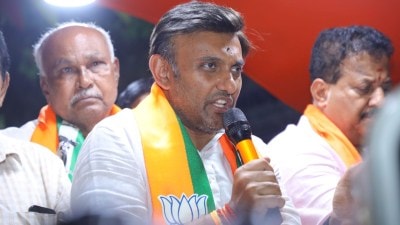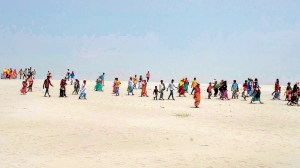- India
- International
Rebels with an art cause
Clark House Initiative has found a way to survive.
 For Amol Patil’s show Social Theatre, artists Prabhakar Pachpute and Yogesh Barve lent their editing talents to reduce production costs. ( Source: Express photo by Prashant Nadkar )
For Amol Patil’s show Social Theatre, artists Prabhakar Pachpute and Yogesh Barve lent their editing talents to reduce production costs. ( Source: Express photo by Prashant Nadkar )
In 2010, when Clark House Initiative announced itself on the art scene, it wasn’t through an exhibition of art works, but a festival of films from the Northeast. They invited entries and received a variety of responses. Some documentaries were about the region’s cuisines, others were travelogues.
But it was two political films — one that spoke of the need for an independent Gorkhaland, and another that made a case against the Armed Forces (Special Powers) Act — that excited the founders. The show didn’t draw art patrons the way it would’ve, had the opening been conventional, but it established the space as one with a spirit of rebellion.
Co-founder of the initiative, Zasha Colah says, “We wanted to arm ourselves with projects that would develop a different vocabulary for protest. We were sure that protesting on the streets would not work anymore.”
Sitting on the floor at the Victorian building that houses Clark House, Colah with the co-founder of the initiative, Sumesh Sharma, are talking about how they have been challenging the unsaid strictures that govern formal art spaces in the city. Through political exhibitions, different economic model, innovations in exhibition spaces — Clark House has managed to stand out.
“We didn’t want to be a gallery or an institution. Neither did we want to be funded by someone,” says Sharma. So instead, they’ve created a system and space that is not tied down by convention.

Far removed from the manicured walls that define gallery spaces, the film screenings — their opening show — were held at an old shipping office in Colaba that belongs to Sharma’s father. “It had nails sticking out of the walls, plaster peeling off — there was a sense of history to it,” says Colah. The now renovated office serves as their headquarters.
But Clark House does not limit itself to this space and, over the past four years, has been part of projects hosted at venues across the world. Take for instance its initiative with Groupe Dix10, an artist collective from Paris, and a few Indian artists. As part of that, Clarke House created a multi-lingual interactive book of essays at JJ School of Art to break the language fascism associated with English.
A collaborative project between its member artists Yogesh Barve and Amol Patil with photographer Kemi Bassene from Senegal, which dealt with discrimination, travelled to Paris. This sometimes overt, sometimes, under the surface, subversive language of art seldom wins buyers. And applying for international grants yields little, say the owners, as embassies are hesitant to invest in political artworks .
So, to survive, they’ve developed an alternate model. “We wanted to move away from commercialisation of the art space,” says Colah. Instead of pre-deciding how much to sell the artworks for, the team names a price when a buyer approaches them. For instance, when a few French buyers visited the gallery recently to inquire about a piece by Barve, Sharma and the artist stepped away for a private chat to decide the amount. “Sales from shows are incidental to us,” says Sharma.
With 11 artists as part of its core team, and 35 floating members, Clark House reduces the production costs to a minimum by getting the artists to pitch in. For example, for Patil’s debut solo, Social Theatre, Prabhakar Pachpute edited his videos, and Sharma wrote the description for the essay. “We showcase the artists we like, even if they aren’t big names, and make our money through commissioned works, which we often don’t even lend our name to,” says Sharma. Each member makes more than he or she would in a day job.
The experiment has worked well for them until now. Their artists have been invited to prestigious art shows and collaborations abroad — Kadist Art Foundation, Insert 2014, residencies in South America, Kochi-Muziris Biennale. Their works have also been acquired by foundations and museums abroad.
Take for instance Prabhakar Pachpute’s show “Canary in the Coalmine”, about the harsh lives of miners, that has been acquired by a museum in Mauritius. Their initiative at restoring AA Raiba’s works has brought this near-forgotten artist a place in art collections across the world. Colah says, “When we started, people thought we are coming from a place of naivety. The truth is we come from a place of knowing.”
kevin.lobo@expressindia.com
Apr 27: Latest News
- 01
- 02
- 03
- 04
- 05








































